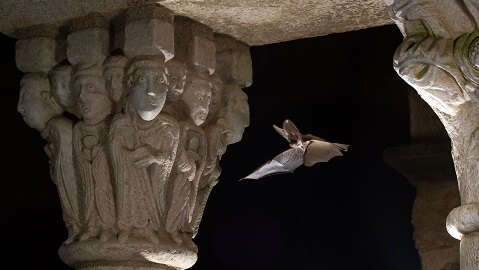Poor image of bats undermines conservation efforts
You might think that bats are scary. But do you know what would be even scarier? To live in a world without them. Bats are key providers of ecosystem services, and their disappearance would translate into enormous economic losses and arguably wide-scale ecosystem collapse.

Bats play an essential role in ecosystems, but myths and scaremongering undermine efforts to protect them, according to a study involving ICTA-UAB.
Yet, despite their vital importance for human well-being and ecosystem functioning, bats have long been subject of disdain, persecution and cultural prejudice. These negative stigmas have recently been reinforced by virological studies that have attracted widespread coverage on the media. By portraying bats solely as a threat to human health, the media can provide a skewed vision of the group and reinforce a culture of fear that undermines decades of conservation efforts, according to an international study carried out by the Institute of Environmental Science and Technology of the Universitat Autònoma de Barcelona (ICTA-UAB).
The study reviewed more than 1,000 media articles focusing on bats in 15 newspapers from the five most populated countries in Western Europe. The study examined the extent to which bats were presented as a threat to human health and the general attitudes towards bats that such articles supported. The study, published in the scientific journal EcoHealth, found that while most of the ecological articles did not present bats as a threat (97%), most articles focusing on diseases did (80%). Importantly, the article also modelled the active response from the readership based on the number of online comments. The authors found that articles framing bats as a threat to human health attract a higher number of reader comments than those framing bats in neutral or positive terms.
As the end of October approaches, cities across the world are invaded by decorations portraying one of Halloween's most terrifying symbols: bats. This association between bats and Halloween reflects a long-standing association between this important group and wide-spread cultural prejudice due to legends, myths and folklore. “Alarmingly, these negative stigmas with which bats have been traditionally associated are being rapidly reinvigorated by fear-inducing media representations of bats as a major threat to human health”, explains Álvaro Fernández-Llamazares, researcher of ICTA-UAB who participated in the study. “By reinforcing a culture of fear, the demonization of bats can swiftly erode the values that society places on bats and consequently undermine ongoing conservation efforts”, he adds.
“While fear easily spreads from person to person, just like a virus, values such as respect or esteem for bats take a long time to sediment”, says Adrià López-Baucells, the lead author from the Natural Sciences Museum of Granollers. Although bats (as many other animal groups, including pets) can potentially transmit some diseases to humans, they are also responsible for numerous benefits such as the control of pathogen-carrying mosquitos or agricultural pests, seed dispersal or pollination. “Given that articles reinforcing bats’ negative stigma have greater potential of going viral, it is of utmost importance to highlight the myriad ways in which bats contribute to human well-being and ecosystem health, and the multiple ecosystem services they provide from local to global scales”, he emphasizes.
The authors urge that an integrated and interdisciplinary approach to articulate bat-related media communication is urgently needed to provide society with a comprehensive and unbiased perception of bats. In the current context following the COVID-19 pandemic, the need to tell positive stories about bats, their myriad values, and all the ecosystem services they provide has perhaps never been more critical. Reframing bat-related information on the media is unquestionably of the essence if bats are to persist for many Halloweens to come.
Reference:
López-Baucells, A., Revilla-Martín, N., Mas, M., Alonso-Alonso, P., Budinski, I., Fraixedas, S., Fernández-Llamazares, Á. (2023) Newspaper coverage and framing of bats and their impact on readership engagement. EcoHealth, 20(1): 18–30. doi: 10.1007/s10393-023-01634-x